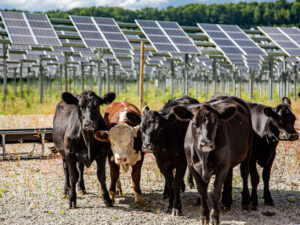 (888) 895-1776
(888) 895-1776
 Garrett Hourigan
Garrett Hourigan  May 15, 2024
May 15, 2024  0 Comment
0 Comment

What is Agrivoltaics?
Agrivoltaics is the process of combining agriculture and solar energy production on the same land. The practice of agrivoltaics is becoming increasingly popular as it maximizes land-use efficiency while creating more localized energy. There are several different applications for agrivoltaics including for commodity crops, livestock grazing, specialty crops, greenhouses, and rooftop agriculture. Let’s look at the specific use cases in more detail.
Agrivoltaics for Commodity Crops
When using agrivoltaics for commodity crops there are several pros and cons that must be considered. Large scale commodity crops such as wheat, corn, and rice offer a unique opportunity for photovoltaic solar integration. The panels are often arranged in a linear vertical bifacial array. This means the panels are installed upright and generate electricity one side at a time depending on the sun’s position. By optimizing panel height and row spacing, microclimates can be created under the panels leading to higher crop yields and cost savings. Agrivoltaics projects for commodity crops tend to be large due to the nature of the crops and space needed to harvest them. Since these projects are so large, they often require high capital costs, especially in the early days. Overall commodity crops present a great opportunity for agrivoltaics, primarily when it comes to large projects.
Agrivoltaics for Livestock Grazing
The use of agrivoltaics for livestock grazing has gained popularity in the past few years due to its straightforward approach. Solar panels are set up in a fixed ground mount array, meaning the panels are angled at the sun in the most optimal position for energy production. Due to the panels’ fixed positions, strategic placement can create shade for the livestock creating an effective dual-land use. However, there are potential challenges that may arise when developing agrivoltaics for livestock grazing such as zoning ordinance issues and potential infrastructure damage from larger livestock animals. With proper planning and mitigation the use of agrivoltaics for livestock can prove to be very beneficial.
Agrivoltaics for Specialty Crops
Specialty crops offer a unique opportunity for agrivoltaics due to their unique needs and high economic value. Solar panels are often set up in a tracking ground mount array. This type of array utilizes GPS technology in order to rotate the panels towards the sun throughout the day. Due to their rotating nature these solar panels can be strategically placed in order to shade drought stressed crops or as a barrier to protect high-value crops from adverse weather. Some potential challenges when it comes to agrivoltaics for specialty crops include complex project planning due to the crop’s unique growth patterns and high initial project costs.
Agrivoltaics for Greenhouse Integration
Greenhouses and the crops they produce can benefit greatly from agrivoltaics. A building integrated bifacial array is most common for this type of project as it embeds solar panels into the greenhouse. These installed panels are usually semi-transparent meaning enough sunlight to promote plant growth passes through the panels while they are simultaneously harvesting energy. While these semi-transparent panels are beneficial, especially for greenhouse agrivoltaics projects, they are less efficient compared to typical opaque solar panels. Opaque solar panels operate with an average efficiency of 15% versus an average of 7.2% for semi-transparent solar panels. While the use of embedded semi-transparent panels can present itself as a challenge, proper planning can easily mitigate risk and create a beneficial dual-land use for any greenhouse.
Agrivoltaics for Rooftop Agriculture
Another less used but beneficial use of agrivoltaics is in rooftop agriculture. Rooftop agriculture is a type of urban agriculture in which crops and other plants are grown on the top of buildings. Due to the unique nature of rooftop agriculture, a rooftop ballasted or pergola array type is most ideal. A rooftop ballasted array contains flat, angled solar panels directed at the sun similar to a fixed ground mount array. A rooftop pergola array is installed as an elevated covering with solar panels on top. By combining agrivoltaics with rooftop agriculture, the production of both food and energy is localized often leading to cost savings. However, due to the confined amount of space on most rooftops, the potential for larger scale agrivoltaics projects is low.
Can Agrivoltaics Projects Create Synergies in My Business?
As seen above, agrivoltaics projects can create various synergies within any agricultural business. Through the utilization of different array types, crop types, and land types (rural vs. urban) agrivoltaics can create real benefits for any farm.
How Can Agrivoltaics Projects Help My Community?
There are numerous ways in which agrivoltaics can help build and empower communities. For starters, agrivoltaics projects can help optimize a community’s power & agriculture at the same time. By developing agrivoltaics alongside microgrids, communities can become more energy-independent leading to lower overall energy costs and enhanced grid reliability. On top of this, agrivoltaics offer a host of environmental benefits such as land optimization, water conservation, and improved biodiversity. These environmental benefits can lead to more prosperous agricultural land while improving the value of the land.
If you have any questions regarding a renewable energy project on your property, give us a call today at (888) 895-1776 or email us at [email protected].